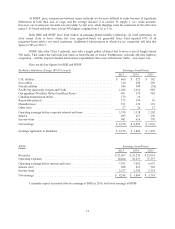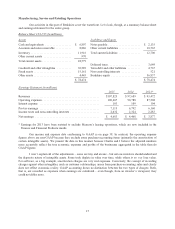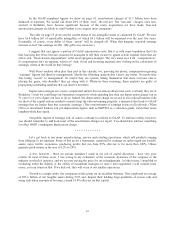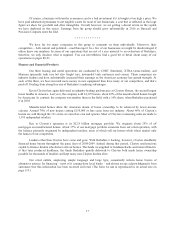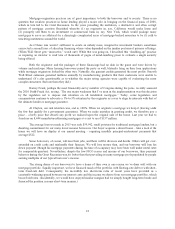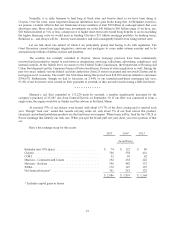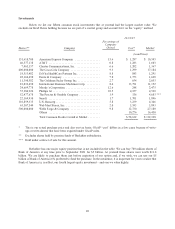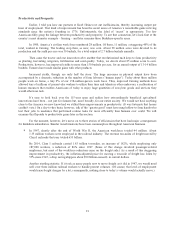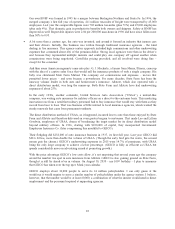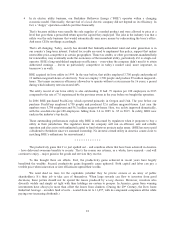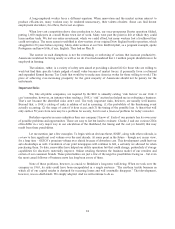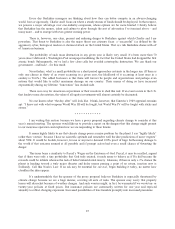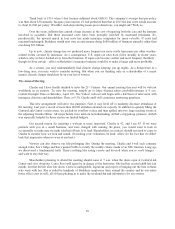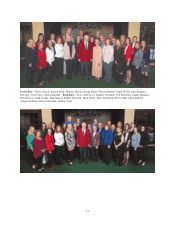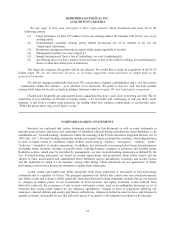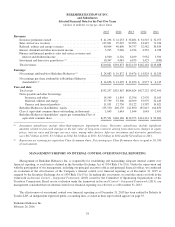Berkshire Hathaway 2015 Annual Report Download - page 26
Download and view the complete annual report
Please find page 26 of the 2015 Berkshire Hathaway annual report below. You can navigate through the pages in the report by either clicking on the pages listed below, or by using the keyword search tool below to find specific information within the annual report.A long-employed worker faces a different equation. When innovation and the market system interact to
produce efficiencies, many workers may be rendered unnecessary, their talents obsolete. Some can find decent
employment elsewhere; for others, that is not an option.
When low-cost competition drove shoe production to Asia, our once-prosperous Dexter operation folded,
putting 1,600 employees in a small Maine town out of work. Many were past the point in life at which they could
learn another trade. We lost our entire investment, which we could afford, but many workers lost a livelihood they
could not replace. The same scenario unfolded in slow-motion at our original New England textile operation, which
struggled for 20 years before expiring. Many older workers at our New Bedford plant, as a poignant example, spoke
Portuguese and knew little, if any, English. They had no Plan B.
The answer in such disruptions is not the restraining or outlawing of actions that increase productivity.
Americans would not be living nearly as well as we do if we had mandated that 11 million people should forever be
employed in farming.
The solution, rather, is a variety of safety nets aimed at providing a decent life for those who are willing to
work but find their specific talents judged of small value because of market forces. (I personally favor a reformed
and expanded Earned Income Tax Credit that would try to make sure America works for those willing to work.) The
price of achieving ever-increasing prosperity for the great majority of Americans should not be penury for the
unfortunate.
Important Risks
We, like all public companies, are required by the SEC to annually catalog “risk factors” in our 10-K. I
can’t remember, however, an instance when reading a 10-K’s “risk” section has helped me in evaluating a business.
That’s not because the identified risks aren’t real. The truly important risks, however, are usually well known.
Beyond that, a 10-K’s catalog of risks is seldom of aid in assessing: (1) the probability of the threatening event
actually occurring; (2) the range of costs if it does occur; and (3) the timing of the possible loss. A threat that will
only surface 50 years from now may be a problem for society, but it is not a financial problem for today’s investor.
Berkshire operates in more industries than any company I know of. Each of our pursuits has its own array
of possible problems and opportunities. Those are easy to list but hard to evaluate: Charlie, I and our various CEOs
often differ in a very major way in our calculation of the likelihood, the timing and the cost (or benefit) that may
result from these possibilities.
Let me mention just a few examples. To begin with an obvious threat, BNSF, along with other railroads, is
certain to lose significant coal volume over the next decade. At some point in the future – though not, in my view,
for a long time – GEICO’s premium volume may shrink because of driverless cars. This development could hurt our
auto dealerships as well. Circulation of our print newspapers will continue to fall, a certainty we allowed for when
purchasing them. To date, renewables have helped our utility operation but that could change, particularly if storage
capabilities for electricity materially improve. Online retailing threatens the business model of our retailers and
certain of our consumer brands. These potentialities are just a few of the negative possibilities facing us – but even
the most casual follower of business news has long been aware of them.
None of these problems, however, is crucial to Berkshire’s long-term well-being. When we took over the
company in 1965, its risks could have been encapsulated in a single sentence: “The northern textile business in
which all of our capital resides is destined for recurring losses and will eventually disappear.” That development,
however, was no death knell. We simply adapted. And we will continue to do so.
24


